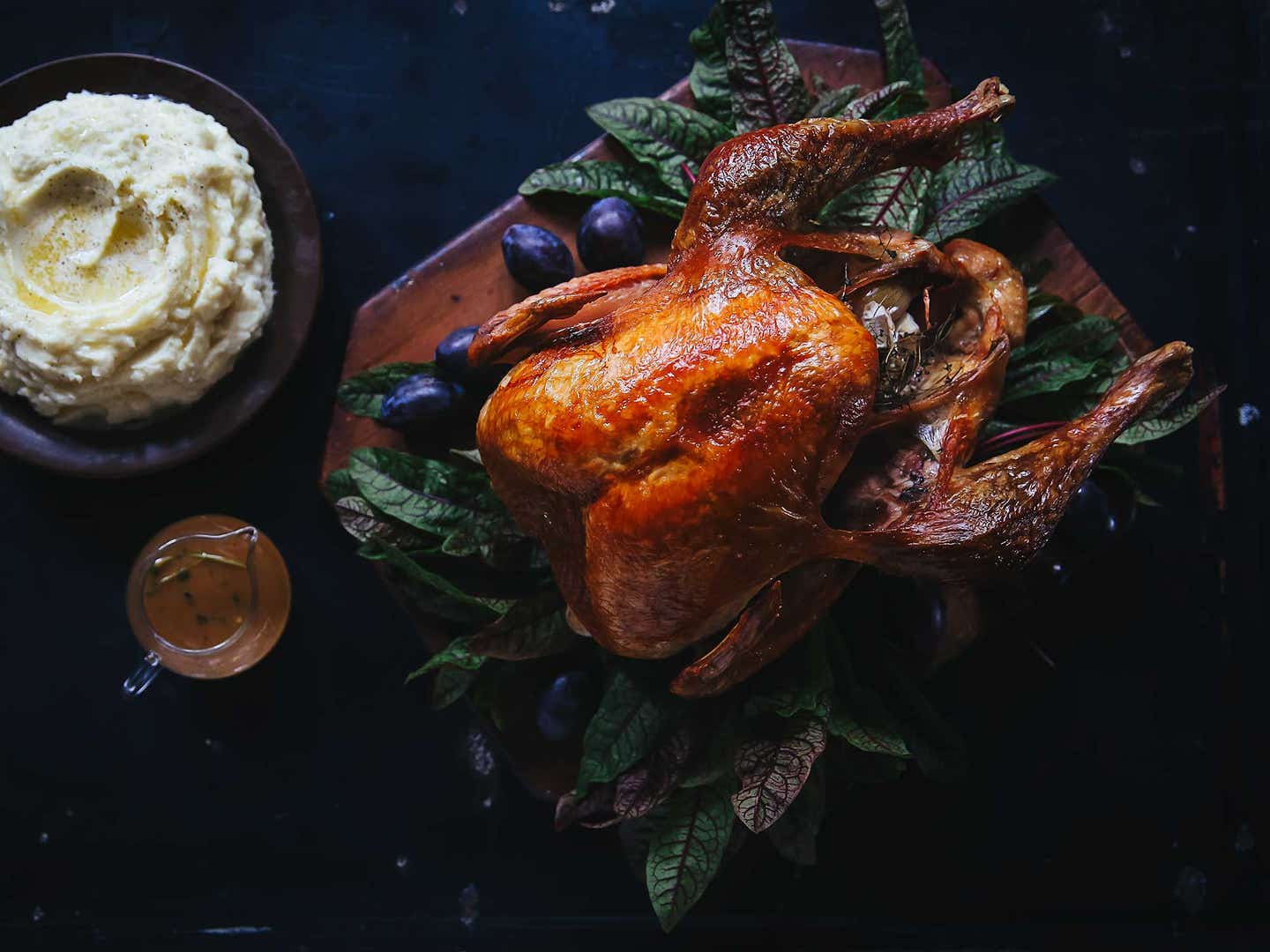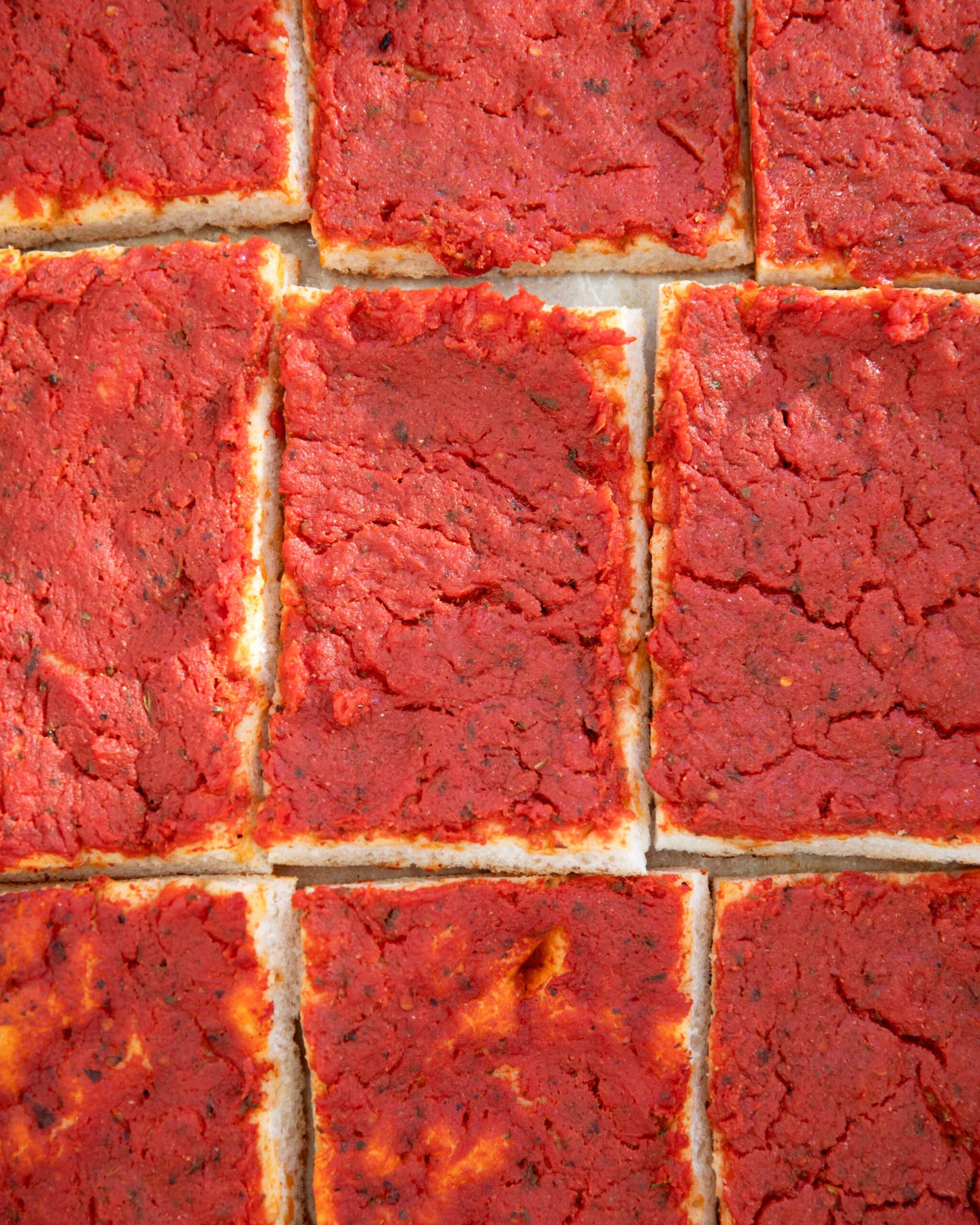
The Best Way to Roast a Thanksgiving Turkey is to Stop Worrying About It
No spatchcocking, no brining, no basting—this is the easiest, most satisfying way to prepare your bird
There used to be a time when all people did with their Thanksgiving turkeys was roast them in a pan. Sure, there was the annual round of timorous self-questioning beforehand: Should I stuff the bird, and with what? Did I tie the legs last year or leave them untrussed? Should I brine it? How will I know when it’s done roasting?
Roasting turkey has its moments of doubt for sure, like how to treat a large-breasted bird versus a heritage one (the answer: rely on thermometers not clocks), and we’ve all suffered through the occasional turkey so overcooked that no amount of gravy could save it. But when done right, it can be a masterpiece of nostalgia and deliciousness. And I miss the simpler days, before all the fuss of spatchcocking and brining, when all you had to do on Thanksgiving was put a damned turkey in the oven.
In culinary school, we were taught the simple, universal principles of perfect roasting: shape the meat so that the parts get cooked as evenly as possible, get a nice brown crust on the outside using a targeted amount of high heat, and keep air evenly circulating all around the meat at all times. We didn’t rely on recipes—we took temperature (the sweet spot is pulling the meat out around 145° for most roasts) or checked the color of running juices in the thickest parts to determine doneness (for turkey, they should be relatively clear, not too pink). We learned to salt by instinct. And we basted the meat, well, if or when it looked like it needed to be basted. Point being: roasting is about instinct. If you trust yourself, there’s really not much that can go wrong.
Because even the best roast turkeys are usually still just pretty good, I’ve let my friends and family talk me into a thousand different turkey cooking methods. Probably like you, I’ve flipped through decades of magazine articles—and even written some myself—touting new turkey ideas and flavorings. I’ve survived novel-length family email chains, all seeking to answer the question “How should we do our turkey this year?”
One year, we confited the legs and roasted the breasts separately (probably my favorite of the experiments). More than once we've deep-fried our turkey in a vat of peanut oil in a gadget invented specifically for deep-frying turkeys. We've wet-brined in giant tubs. We've injected flavorings into our turkey with a syringe. I've roasted a bird partially upside down, and slow-grilled a turkey over indirect heat from coals. I've never had a turkey cooked underground, but I'm sure someone has, and that person would be glad to tell you all about how just okay it was. I've had smoked turkey. And a bird sous vide in parts. But never have I ever had a turkey that really blew me away.
That’s because turkey is just never going to be the king of meats. Even the blandest Butterballs versions have at least some gamey flavor, and even the plumpest don’t have quite enough fat to keep the disproportionate amounts of meat juicy or yield many decadent pickings beyond that bronzed, paper-thin shell of crispy skin (as good as it may be).
To me (and I'm not alone), simply salting and roasting is and always will be the easiest, most classic, and least absurd way to get crispy, deeply browned skin, and meat that's not water-logged or so salty it tastes like it came from the ocean (read: wet-brined). So slap some salt on the skin, give it a day to dry off in the fridge, and then, guys, just put the damned turkey in the oven.
Here are my methods to a simple but iconic roasted bird:
Pre-Salt Generously
Even I have been guilty of calling this method “dry brining” before—mostly because that name makes salting a turkey sound like an adequate and valid defense against the die-hard wet briners out there, bless their patient souls. But, as brining has everything to do with soaking in salty liquid (which I think creates unnaturally spongy meat), we should really just call this step pre-salting.
One day before cooking, pat the fresh or fully defrosted bird dry with paper towels and salt and pepper it very well all over. Refrigerate it, uncovered and breast side up, for a full day, letting any excess moisture from the skin evaporate.
Add Fat if You Want To
Because turkey breast is especially lean, I like to rub softened fat beneath the skin just before roasting. It melts and gives the meat extra flavor, richness, and moisture. Duck fat is wonderful for this, and it fortifies the poultry flavors, but unsalted butter works well, too. You really don’t need to baste the meat with more fat as it cooks. A combination of low-heat and high-heat roasting helps render then crisp the skin.
Don't Bother Trussing
Part of the blame for dry white meat turkey actually falls on the legs: Because they take longer to cook through, by the time they are done, the breast may be overcooked. The meat in the fold between the thigh and the breast can be some of the last meat to finish cooking when trussed. Trussing prevents air from circulating around and between the legs, which can cause them to take even longer to cook.
I don’t tuck the wings either, but if you’re cooking a massive bird (above 15 pounds), you may want to tent them part of the way through with foil to prevent the tips from burning.
Stuff—But Not With Stuffing
Especially if you’re not trussing the legs, adding some aromatics into the cavity of the bird seems to help slow the cooking process and prevent dried-out white meat. I fill mine with a combination of halved lemons and shallots, cut heads of garlic, and bushels of herbs. (If desired, after your turkey is done roasting, you can squeeze out the roasted garlic cloves and whisk them into your gravy for added flavoring.)
Heat From Low to High
For forever, I started my bird on high heat to kick-start the browning of the skin, then lowered it to roast slowly the remainder of the way. This works well enough. But the best crispy skin I’ve ever achieved came from starting off at low temperature (usually 350°), when the skin can more fully render onto the meat, and then finishing the turkey on higher heat (around 425°).
And Don't Worry About Basting
Basting or brushing the bird with the juices and drippings from the pan presents several problems. For one, it distributes more moisture onto the top skin of the bird, preventing the outermost layer from getting crispy. But secondly, it slowly steals from the pan juices that can and should later become your gravy. In this particular recipe, you do not need to baste in order to achieve crispy bronze skin. But if you insist, baste with rendered duck fat or from a fresh cup of olive oil instead.
Keep Reading
Continue to Next Story










